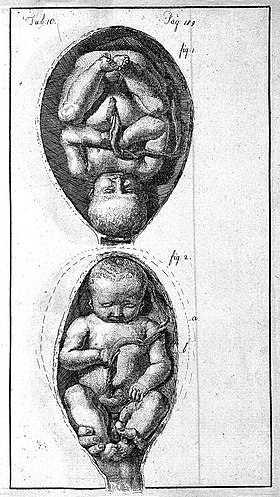External cephalic version
| External cephalic version | |
|---|---|
 Child presenting head first (top) and feet first (bottom)[1] | |
| Specialty | Obstetrics |
| ICD-9-CM | 73.91 |
External cephalic version (ECV) is a process by which a
ECV is endorsed by the
ECV can be contrasted with "internal cephalic version", which involves a hand inserted through the cervix.[7]
Medical use
ECV is one option of intervention should a breech position of a baby be found after 36 weeks gestation. Other options include a planned caesarian section or planned vaginal delivery.[4]
Success rates
ECV has an average success rate of around 58%,[3] between 40 and 64% depending on whether it is the mother's first child or not. (40% for first-time mothers and closer to 60% for women who have had previous children.[citation needed]
Various factors can alter the success rates of ECV. Practitioner experience, maternal weight, obstetric factors such as uterine relaxation, a palpable fetal head, a non-engaged breech, non-anterior placenta, and an amniotic fluid index above 7–10 cm, are all factors which can be associated with higher success rates. In addition, the effect of
Following successful ECV, with the baby turned to head first, there is a less than 5% chance of the baby turning spontaneously to breech again.[9]
Contra-indications
Some situations exist where ECV is not indicated or may cause harm. These include recent
Risks
As with any procedure there can be complications most of which can be greatly decreased by having an experienced professional on the birth team. An ultrasound to estimate a sufficient amount of amniotic fluid and monitoring of the fetus immediately after the procedure can also help minimize risks.[10]
Evidence of complications of ECV from clinical trials is limited, but ECV does reduce the chance of breech presentation at birth and caesarian section. The 2015 Cochrane review concluded that "large observational studies suggest that complications are rare".[9][11]
Typical risks include
Successful ECV significantly decreases the rate of cesarean section, however, women are still at an increased risk of instrumental delivery (
Technique
The procedure is undertaken by either one or two physicians and where emergency facilities to undertake instrumental delivery and caesarian section are at hand. Blood is also taken for cross-matching should a complication arise.[12] Prior to performing ECV, an ultrasound of the abdomen is performed to confirm the breech position and the mother's blood pressure and pulse are taken. A cardiotocography (CTG) is also performed to monitor the baby's heart.[4][14]
The procedure usually lasts a few minutes and is monitored intermittently with CTG.
ECV performed before term may decrease the rate of breech presentation compared to ECV at term, but may increase the risk of
Following the procedure, a repeat CTG is performed and a repeat ultrasound will confirm a successful turn.[4] Should this first attempt fail, a second attempt on another day can be considered.[9]
In addition, to prevent Rh disease after the procedure, all rhesus D negative pregnant women are offered an intramuscular injection of anti-Rh antibodies (Rho(D) immune globulin).[4]
History
ECV has existed since 384–322 B.C., the time of
ECV's safety has continued to be a longstanding controversy. Following a protocol developed in Berlin, ECV did increase in popularity in the United States in the 1980s.[12] The procedure has been increasingly considered as low risk of complications and its improvement in safety as a result of the routine use of electronic fetal monitoring, waiting until closer to term and the replacement of anaesthesia by tocolysis,[19] has seen a recent resurgence.[6]
References
- ^ Burton, John (1751). "An essay towards a complete new system of midwifry, theoretical and practical. Together with the descriptions,causes and methods of removing, or relieving the disorderspeculiar to pregnant ... women, and new-born infants". J. Hodges. Retrieved 25 September 2018.
- ^ S2CID 71800278.
- ^ PMID 29494082, retrieved 14 April 2020
- ^ a b c d e f g h i "Breech baby at the end of pregnancy" (PDF). www.rcog.org. July 2017. Retrieved 23 September 2018.
- S2CID 38547277.
- ^ a b c Ehrenberg-Buchner, Stacey (3 August 2018). "External Cephalic Version: Overview, Technique, Periprocedural Care". Medscape.
- PMID 13669146.
- ISBN 9780727917348.
- ^ a b c d "External Cephalic Version and Reducing the Incidence of Breech Presentation" (PDF). www.rcog.org.uk. 2010. Retrieved 23 September 2018.
- S2CID 12917755.
- PMID 25828903.
- ^ PMID 9750541.
- S2CID 16394070.
- ^ "What Is External Cephalic Version?". WebMD. Retrieved 23 September 2018.
- ^ "37 weeks pregnant". www.nct.org.uk. Retrieved 23 September 2018.
- PMID 26222245.
- PMID 25674710.
- S2CID 9757809.(subscription required)
- ^ PMID 28328063.
